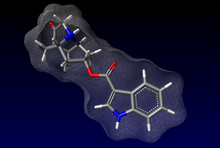 | |
 | |
| Clinical data | |
|---|---|
| AHFS/Drugs.com | Monograph |
| MedlinePlus | a601001 |
| Pregnancy category |
|
| Routes of administration | Intravenous, by mouth |
| ATC code | |
| Legal status | |
| Legal status |
|
| Pharmacokinetic data | |
| Protein binding | 69 to 77% |
| Elimination half-life | 8.1 hours |
| Identifiers | |
| |
| CAS Number | |
| PubChem CID | |
| DrugBank | |
| ChemSpider | |
| UNII | |
| KEGG | |
| ChEMBL | |
| CompTox Dashboard (EPA) | |
| ECHA InfoCard | 100.130.141 |
| Chemical and physical data | |
| Formula | C19H20N2O3 |
| Molar mass | 324.380 g·mol−1 |
| 3D model (JSmol) | |
| |
| |
| | |
Dolasetron (trade name Anzemet) is a serotonin 5-HT3 receptor antagonist used to treat nausea and vomiting following chemotherapy.[1] Its main effect is to reduce the activity of the vagus nerve, which is a nerve that activates the vomiting center in the medulla oblongata. It does not have much antiemetic effect when symptoms are due to motion sickness. This drug does not have any effect on dopamine receptors or muscarinic receptors.
Dolasetron breaks down slowly, staying in the body for a long time. One dose is usually administered once or twice daily and lasts 4 to 9 hours. This drug is removed from the body by the liver and kidneys.
It was patented in 1986 and approved for medical use in 2002.[2] It is on the World Health Organization's List of Essential Medicines.[3]
- ^ Long-term Use of Ondansetron, Dolasetron and Granisetron for the Prevention of Nausea and Vomiting: A Review of the Clinical Effectiveness and Safety [Internet]. CADTH Rapid Response Reports. Ottawa (ON): Canadian Agency for Drugs and Technologies in Health. April 2014. PMID 25610941.
- ^ Fischer J, Ganellin CR (2006). Analogue-based Drug Discovery. John Wiley & Sons. p. 448. ISBN 9783527607495.
- ^ World Health Organization (2021). World Health Organization model list of essential medicines: 22nd list (2021). Geneva: World Health Organization. hdl:10665/345533. WHO/MHP/HPS/EML/2021.02.